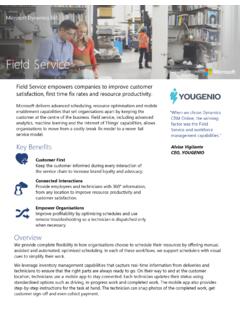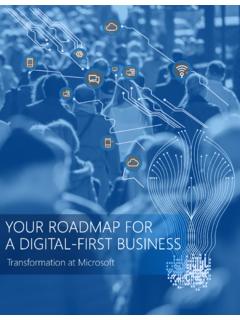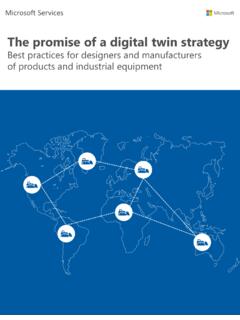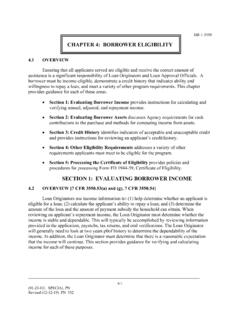Transcription of Creating a culture of digital transformation
1 Creating a culture of digital transformationContents01 Foreword from Cindy Rose 102 Executive summary 303 A culture of digital transformation 704 Collaboration not competition 1105 Embracing fear 1706 Demonstrating value 2307 Respecting your ecosystem 2908 Living agile 3509 Conclusion 4310 Appendix 4612 Cindy Rose Microsoft UK CEO and Area Vice Presidentrganisations across the globe are undertaking their own unique digital transformation journeys.
2 With the rise of AI and machine learning, technology is altering every aspect of the corporate and social landscape, fundamentally changing the way we communicate and disrupting established business goal in this report is to share perspective on the changing UK landscape and to better understand the challenges, and opportunities, facing UK organisations relative to global trends. Fifty-three per cent of UK business and IT leaders we surveyed for this report say their industries will face significant digital disruption within the next two years, yet 47% have no formal digital transformation strategy in place, with many struggling to capitalise on their technology investments to improve business organisations getting it right today aren t the ones waiting to see how trends play out.
3 They are the ones anticipating what comes next and proactively taking steps towards it. These organisations are building strategies that deliver sustainable growth and are using technology to differentiate and drive transformation . The research shows that the biggest challenge organisations are facing in accelerating transformation is not necessarily around the new technology itself, but the cultural change required to derive value from it. Yet only 23% of UK business and IT leaders says their organisation is undertaking a major programme to change its workplace and organisational , how do you create a culture that serves to foster and accelerate digital transformation ?
4 In this report there are perspectives from hundreds of CEOs and business leaders from a range of industries, as well as middle managers and junior employees, in addition to insight from subject matter experts like world-renowned Stanford University psychologist Carol Dweck. Together these perspectives give a real-life view of the cultural changes that are needed to support successful digital transformation is not a technology deployment or an IT exercise, it s a people exercise. Business leaders must therefore embrace cultural transformation from the top and explore the behavioural shifts that are needed to bring about lasting change.
5 Above all else, this requires belief and commitment. Changing human behaviour is not always easy and there s a level of discomfort that comes with stepping into the unknown. Some people thrive on it, some people can learn it, and some people feel paralysed by it, so this must be handled sensitively. In this report, there are pragmatic and tangible steps that every company can take to help both business leaders and employees on their s mission is to empower every person and every organisation on the planet to achieve more. Today that refers as much to Creating the right culture to enable digital transformation as it does to technology.
6 digital transformation is a journey that s never finished. No matter where you are on that journey, our aim at Microsoft UK is to help accelerate your success and ability to compete in a digitally transformative marketplace. Cindy Rose Microsoft UK CEO and Area Vice President01 ForewordO3402 Executive summaryast year, our report digital transformation : The Age of Innocence, Inertia or Innovation? provided the most extensive insight to date on the impact of digital transformation on UK organisations across a broad range of sectors. Its findings were clear: pervasive access to new digital services is changing every aspect of business from disrupting corporate structures and practices, to catalysing innovation and unlocking new opportunities for it also uncovered widespread discrepancies between the ways in which organisations view digital transformation and, in particular, to what extent they are willing and able to embrace the strategies, initiatives and operating models necessary to successfully implement it.
7 With those findings in mind, this year s follow-up report delves deeper into the factors, obstacles and attitudes influencing UK organisations ability to succeed as they navigate their own unique digital transformation journeys. We explore what it takes to create a true culture of digital transformation . A culture that is not only agile and progressive enough to evolve alongside new technological inventions and applications, but that also fosters a sense of empowerment and engagement among an organisation s workforce along the embarking on the study, we drew upon respected conceptual models1 to build our own model of an agile digital culture .
8 This model is based on seven key dimensions: people and leadership; structure; technology; strategy; tasks; politics; and ethics. (See figure 1.) Using a combination of field research, interviews with subject matter experts and business leaders, an online YouGov survey, workshops, and a chatbot study to capture real-time feedback from employees, we then developed and tested hypotheses against each of the seven dimensions. (See figure 2.)Figure 1. Seven dimensions of an agile digital cultureStructureEquilibriumAgile digital cultureStrategyTechnologyPoliticsEthicsT ask sPeople & leadership1 Models used include: Socio-Technical Systems Theory, Leavitt s Framework for Organisational Effectiveness, Lewin s Force Field Model and Model of Change Process, and Miles and Snow s Strategy TypologyLWithin our model of agile digital culture , each of the seven dimensions fall into one side of an equilibrium.
9 The first side represents organisational structures ( policies, ethics and people) and the other represents what the organisation does ( the tools and technology it uses).56 Within the key findings, we see that technology and ethics are the most significant drivers of an agile digital culture . Indeed, while UK leaders are strongly focused on introducing new technologies to sharpen everything from operating practices and strategic decision-making to employee management and customer experiences, they are also highly attuned to the pressing need to develop clear governance around data usage, cyber security and themselves remain central to digital transformation as the originators and mission-setters of change.
10 Yet we reveal the process must be fully two-way, with employees given the tools and support to innovate, fail, and collaborate with new technologies, both individually and as a group. They should then be free to offer unrestricted feedback on how successfully those technologies augment their day-to-day roles, boost productivity and enhance job satisfaction. In other words, adoption must be driven from the ground up, not autocratically delivered from the top unsurprisingly, then, the organisations leading the charge on Creating a culture of digital transformation tend to be the ones whose leaders are adopting this collaborative approach that is the UK leaders among the 58% surveyed that agree that augmenting their workforce with technology is more important for productivity than simply automating workforce tasks.














